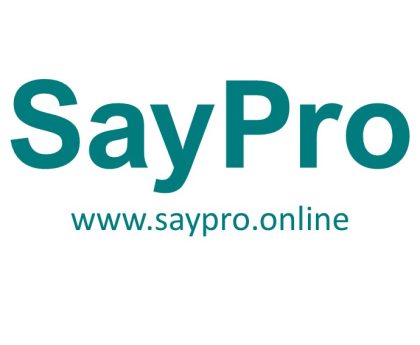SayPro Documents Required from Employee Customer Satisfaction Survey Results: Data from surveys to assess the quality of customer support provided from SayPro Monthly January SCMR-17 SayPro Monthly Help Desk: Provide customer support through chat, email, or phone by SayPro Online Marketplace Office under SayPro Marketing Royalty SCMR
Overview:
The Customer Satisfaction Survey Results are a crucial document for evaluating and improving the quality of customer support provided by the SayPro Monthly Help Desk. These surveys capture valuable feedback directly from customers regarding their experiences with support services delivered via chat, email, or phone. By gathering and analyzing customer responses, the Help Desk team can identify strengths, areas for improvement, and actionable insights to enhance overall support quality.
Customer satisfaction surveys provide both qualitative and quantitative data, giving the team a comprehensive understanding of customer needs and expectations, and enabling them to track the effectiveness of improvements over time.
1. Purpose of Customer Satisfaction Survey Results
A. Assess Customer Experience
The customer satisfaction surveys help measure how satisfied customers are with their support interactions, including:
- Response Timeliness: Whether customers felt their issues were addressed in a timely manner.
- Resolution Effectiveness: Whether their issues were resolved to their satisfaction.
- Support Agent Performance: How customers perceive the professionalism, expertise, and attitude of the support agents.
B. Identify Improvement Areas
Survey results enable the Help Desk team to spot recurring issues and areas where they can enhance their performance, such as:
- Training Needs: If customers consistently express dissatisfaction due to specific support agent actions or lack of knowledge.
- Platform Usability: Identifying areas in the SayPro online marketplace that might be confusing or difficult for customers to navigate.
- Product/Service Issues: Understanding any recurring complaints related to the platform’s products or services.
C. Increase Customer Retention
By responding to customer feedback and making necessary improvements, SayPro can increase customer loyalty and retention. Positive survey results indicate that the support team is effectively meeting customer expectations, while negative feedback offers an opportunity to rectify issues before they escalate.
D. Track Progress Over Time
Tracking survey results over time allows the Help Desk team to assess whether changes implemented in response to customer feedback have led to improvements in satisfaction levels. It also provides a benchmark for ongoing performance.
2. Key Components of Customer Satisfaction Survey Results
The Customer Satisfaction Survey Results document should include the following key components to ensure it captures all necessary data for effective analysis.
A. Survey Response Data
- Survey Response Rate: The percentage of customers who completed the survey out of the total number of customers who interacted with support.
- Response Date: The date when the survey responses were collected, providing context for the data (e.g., weekly, monthly, or quarterly).
- Survey Completion Rate: The percentage of surveys fully completed versus those that were started but abandoned.
B. Customer Satisfaction Metrics
- Overall Satisfaction Score: A numerical rating that reflects the customer’s overall satisfaction with the support they received, typically on a scale of 1-5 or 1-10.
- Service Rating: This rating reflects how satisfied customers are with the level of service provided, including their perception of professionalism, courtesy, and communication.
- Response Time Rating: Customers rate how satisfied they were with the timeliness of the support response (e.g., within 1 hour for live chat, 24 hours for email).
- Issue Resolution Rating: The customer’s satisfaction with how effectively their issue was resolved.
- Likelihood to Recommend: Often measured with a Net Promoter Score (NPS), this assesses how likely customers are to recommend SayPro’s customer support to others based on their experience.
C. Qualitative Feedback
- Open-Ended Questions: Space for customers to provide comments or suggestions about their support experience. For example:
- “What did you like most about your support experience?”
- “What could have been done better to resolve your issue?”
- “Do you have any additional suggestions or comments?”
- Common Themes: Analysis of recurring themes or comments that point to specific issues or areas for improvement (e.g., slow response times, unhelpful agent responses, product-related complaints).
D. Demographic Information (Optional)
Some surveys might include optional questions that help identify specific customer groups for deeper analysis, such as:
- Customer Type: Whether the customer is a new user, a long-term user, or a business customer.
- Product or Service Used: The type of product or service the customer was using when they contacted support.
- Support Channel: Whether the survey was completed by a customer who interacted via chat, email, or phone.
E. Customer Feedback Trends
- Trends Over Time: Visual representation of changes in satisfaction ratings, issue resolution effectiveness, and other metrics over weeks, months, or quarters.
- Comparison Against Targets: Measure how the feedback aligns with predetermined performance targets (e.g., aiming for a 90% satisfaction rate).
3. Best Practices for Collecting and Analyzing Survey Results
A. Ensure Survey Accessibility
- Multiple Platforms: Ensure that the survey is accessible through the same channels that customers use to interact with support (e.g., chat, email, phone).
- Timing: Send the survey soon after the support interaction, ideally within 24 hours, to ensure that the customer’s experience is fresh in their mind.
B. Consistent Survey Distribution
- Uniform Distribution: Distribute the survey consistently to all customers who interact with the support team. Random or biased selection may skew the data.
- Incentives for Participation: Offer incentives such as discounts or promotional codes to encourage customers to complete the survey, increasing response rates.
C. Act on the Feedback
- Analyze Data Regularly: Review survey results weekly, monthly, or quarterly to ensure timely action is taken based on customer feedback.
- Implement Changes: If feedback indicates consistent dissatisfaction in a particular area (e.g., long response times or unhelpful support agents), develop action plans for improvement.
D. Segment Customer Feedback
- By Support Channel: Evaluate feedback separately for chat, email, and phone interactions to understand channel-specific issues.
- By Customer Type: Break down satisfaction scores by customer demographics, such as new users versus long-term users, to spot specific challenges faced by different groups.
- By Product or Service: Track which products or services customers are having issues with, which could highlight areas for product improvement.
4. Using Survey Data for Continuous Improvement
A. Identifying Systemic Issues
Survey results can highlight ongoing problems that affect multiple customers. For example, if several customers report similar issues with a particular feature on the SayPro platform, it can indicate a systemic problem that needs attention from the development team. The customer support team can then escalate this issue to the appropriate department.
B. Training and Development
If surveys consistently show dissatisfaction with support agent interactions, it may indicate the need for additional agent training. For example:
- Product Knowledge: If customers report that agents lack knowledge about certain product features, targeted training sessions can be implemented.
- Communication Skills: If customers indicate frustration with communication style or clarity, agents can undergo communication skills training.
- Escalation Handling: If customers feel that their issues were not escalated in a timely manner, the Help Desk team can review and refine their escalation process.
C. Set Improvement Goals
Based on survey feedback, the support team can set specific improvement targets. For instance:
- Reduce Response Time: If survey results show dissatisfaction with slow response times, set a target to reduce response times for certain channels.
- Increase Resolution Effectiveness: If issue resolution scores are low, work with technical teams to improve the resolution process or offer better solutions.
- Increase Customer Satisfaction: If customer satisfaction scores fall below a target threshold, make changes to workflows, training, and communication practices.
5. Reporting and Sharing Results
A. Visual Reporting
Use charts and graphs to present survey data in an easy-to-understand format. Common visualizations may include:
- Bar Graphs: To display satisfaction scores across different support channels or over time.
- Pie Charts: To show the distribution of feedback on specific aspects (e.g., response time, issue resolution).
- Trend Lines: To track customer satisfaction scores over months or quarters.
B. Share Insights with Teams
Regularly share survey results and insights with customer support agents, managers, and other relevant departments. This allows for:
- Actionable Feedback: Frontline agents can review feedback specific to their performance and improve their approach accordingly.
- Cross-Departmental Collaboration: Issues that require attention from other teams (e.g., development, product management) can be shared for collaboration and improvement.
C. Senior Leadership Reporting
Summarize survey results and key insights in monthly or quarterly reports to senior leadership, which can help guide strategic decisions and inform budget allocations for customer support improvements.
Conclusion:
The Customer Satisfaction Survey Results are a crucial document that helps SayPro’s Help Desk monitor the quality of customer support, track performance, and identify areas for improvement. By regularly collecting, analyzing, and acting on feedback, SayPro can continuously enhance the customer experience, reduce recurring issues, and maintain high satisfaction levels across all customer support channels.



